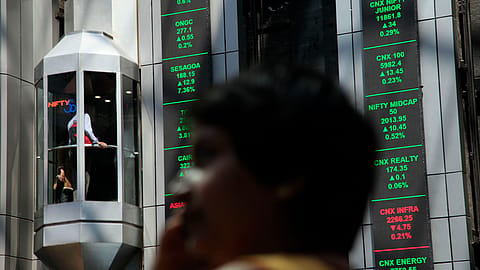Markets give a thumbs down to RBI’s status quo; rate-sensitive auto, realty, bank stocks fall
The broader markets witnessed sharp selling, with the Nifty Midcap100 and the Nifty Smallcap100 indices plummeting 1.5% and 1.1%, respectively.

The Indian equity markets reacted negatively to the Reserve Bank of India’s decision to maintain the status quo on interest rates, with the benchmark indices, the BSE Sensex and the NSE Nifty, falling by up to 0.3% after the policy announcement. Rate-sensitive sectors such as automobiles, real estate, banking and financial services were among the top laggards, dragging down the benchmark indices.
The BSE Sensex declined 261 points, or 0.32%, to hit a low of 80,448.82 during the trade so far, while the NSE Nifty dropped by as much as 105 points to 24,544.15. The broader markets witnessed sharp selling, with the Nifty Midcap100 and the Nifty Smallcap100 indices plummeting 1.5% and 1.1%, respectively.
Earlier today, the Sensex and the Nifty opened a tad lower as caution prevailed in the markets ahead of the RBI policy decision. The mixed cues from global peers amid concerns over new U.S. tariffs also dented sentiment.
On the sectoral front, the Nifty Realty index was the top laggard, falling over 2% after the central bank maintained status quo in its policy meeting, while auto, banking and financial services indices dropped in the range of 0.2-0.8%.
The market saw broad-based selling, with all sectoral indices in the red zone, led by Nifty IT, Energy, FMCG, and Metal.
Of the BSE Sensex pack, 19 of the 30 stocks were trading in the negative, led by Tech Mahindra, Infosys, Eternal, Bajaj Finance, and HCLTech, falling in the range of 1.5-2%. On the other hand, Asian Paints, Trent, ICICI Bank, HUL, and Maruti Suzuki India were the top gainers, rising by up to 2%.
RBI keeps repo rate unchanged
Recommended Stories
Broadly in line with the Street's expectations, RBI’s Monetary Policy Committee (MPC), headed by Governor Sanjay Malhotra, voted unanimously to keep the repo rate unchanged at 5.5% in its latest policy meeting. The MPC also decided to maintain its neutral stance, with the Governor reiterating that the shift in stance reflects the central bank’s flexibility to act in either direction based on incoming data.
After reducing the repo rate by 100 basis points (bps) over the past three policy meetings, bringing the rate down from 6.5% in February to 5.5% in June, brokerages expected the MPC to maintain the status quo in its latest policy review.
While most economists were of the view that the MPC would keep both the repo rate and its “neutral” policy stance unchanged, some expected the central bank to continue frontloading with a 25 bps cut in the August policy meeting.
Naveen Kulkarni, Chief Investment Officer, Axis Securities PMS, said the RBI’s decision to keep the repo rate unchanged was in line with expectations after the regulator front-loaded rate cuts in June 2025 to spur growth. “After the pause in the current meeting, the RBI could opt for a 25 bps rate cut in the upcoming meetings, given a benign inflation forecast and continued focus on growth.”
(INR CR)
For banks, the impact of the repo rate cut was visible in Q1 and it will continue in Q2FY26. For now, net interest margins (NIMs) seem to be bottoming out in Q2. “Banks are expected to see margin improvement over H2, with deposit repricing playing out and some support from the CRR cut announced in the Jun 2025 MPC meeting,” said Kulkarni.
"The RBI has held the repo rate steady at 5.5%, maintaining a neutral stance amid a stable economic backdrop. While inflation forecasts have been revised downwards to 3.1% for the year, the central bank flagged potential year-end pressure, projecting a rise to 4.4% due to seasonal factors,” said Ajit Mishra, SVP-Research, Religare Broking.
With GDP growth pegged at 6.5% and liquidity in surplus, the RBI reiterated its data-dependent approach, staying cautious yet flexible in the face of global uncertainties, he said.
Nikunj Saraf, CEO, Choice Wealth, said the RBI is clearly aware of the storm clouds forming globally—especially the upcoming U.S. tariffs, which threaten to derail India’s export momentum and dampen private capex confidence.
“The forecast for FY26 inflation at just 3.1% gives breathing room, while the steady GDP projection of 6.5% signals cautious optimism. But the real takeaway is RBI’s strategic wait-and-watch mode—it’s not declaring victory, but preparing for agility. This is a classic case of monetary prudence over preemptive action—anchored in data, but alert to global dislocations,” he said.
Notably, the monetary policy decision came against the backdrop of ongoing global uncertainty. The RBI was expected to adopt a “wait and watch” approach amid a hawkish stance from the U.S. Federal Reserve, ongoing trade tensions with the U.S., and recent appreciation of the U.S. dollar index.
(DISCLAIMER: The views and opinions expressed by investment experts on fortuneindia.com are either their own or of their organisations, but not necessarily that of fortuneindia.com and its editorial team. Readers are advised to consult certified experts before taking investment decisions.)









